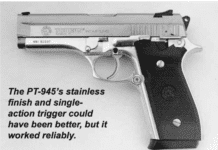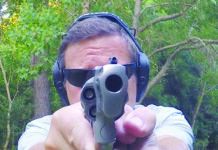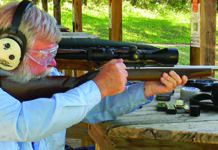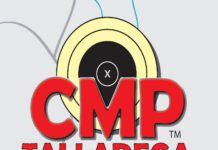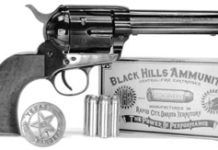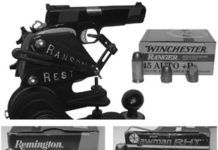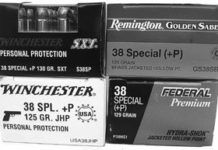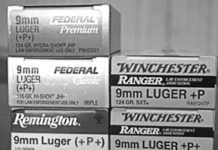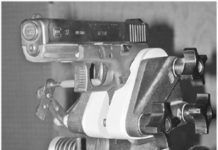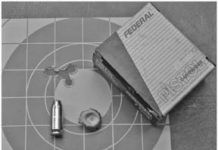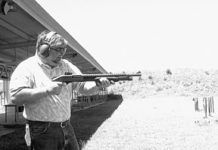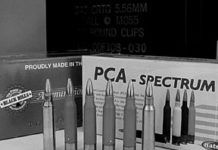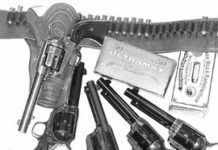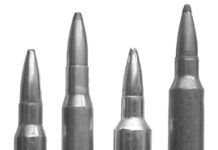Budget .45 Colt Cowboy Guns: Heritage Comes Up Shooting
According to a number of online dictionaries, there is no definition listed for the term, "cowboy gun." Nevertheless, the popularity of revolvers descending from the Colt Single Action Army has brought new meaning to these words. Since 1999 we have tested at least 18 different handguns that fit what we define as a cowboy gun, and now there are two more entering the market.
The Taurus Gaucho No. SA45B, $499, and the Heritage Manufacturing Big Bore Rough Rider No. RR45B5, $379, are six-shot single-action revolvers each with 5.5-inch barrels and chambered for 45 Colt. Some refer to this 1.6-inch-long straight-walled case with a 0.454-inch diameter bullet as .45 Long Colt, but in either case this caliber did not actually exist in the 19th Century. What is important is that these guns are for pleasure first, and they do not come with big price tags.
But their budget prices don't mean we're going to let them off the hook should they prove wanting in one area or another. Physically, the Gaucho and the Rough Rider could not be closer. Indeed, since they are replica guns, any variation from form, whether a positive innovation or not, would more than likely spoil their appeal. Both guns are dark-blued steel. Both guns have a tall front sight and a rear sighting notch exposed when the hammer is pulled back. Sight radius was equal. Each gun cylinder rotated clockwise, and with the loading gate open, the cylinders clicked with the indexing of each chamber. Ejector-rod movement was approximately 2.7 inches for each gun. The hammers on each gun lacked firing pins, using instead a transfer-bar system for greater safety. The Gaucho featured a plastic grip, but the grip on the Rough Rider was wood. The shape of the bell-shaped grips each started with a wide base that tapered to a 4.1-inch neck. Their weight, size, front strap and back strap height were nearly identical.
With so little to distinguish the two guns, our main concerns in this test were accuracy, fit, and function. Our test distance was 25 yards from a sandbag rest with four different choices of ammunition, two modern and two others sold in boxes decorated with Old West graphics. The modern rounds were Winchester's 225-grain Silvertip hollowpoints and Remington's 225-grain lead semi-wadcutters. The remaining ammunition brands, likely being marketed to Cowboy Action shooters, were 250-grain lead flat-point rounds from PMC and Black Hills Ammunition. We also looked back at other .45 Colt cowboy guns we have tested to see how these two newcomers stacked up within the category overall.
.45 Auto Frangible Loads: Our Pick Is Winchester Ranger
Self-Defense .38 Spl. +P Loads: Our Pick Is Winchesters SXT
Our tests of commercially available .38+P revolver cartridges from Federal, Winchester, and Remington show good to acceptable accuracy results and very manageable recoil.
9mm +P and +P+ Cartridges: Winchester & Remington Win
These rounds should have more pop than standard-pressure 9mm Parabellum cartridges, and in three cases we found that to be true — the winners shoot on par with .357 Magnums.
Self-Defense .45 GAP Loads: None Have Everything We Want
Our tests of commercially available Glock Automatic Pistol cartridges from Federal, Winchester, and Speer show disappointing accuracy results and stout recoil.
Survivor Bullet Testing: .45 ACP 230-Grain Hollowpoints
We believe our tests of cartridges from Federal, Winchester, PMC, and Speer can point you toward a topnotch self-defense ammo that you can, and should, evaluate in your own handgun.
Shotguns, Slugs, Buckshot: Whats Right for Effective Self-Defense?
We test several loads in an affordable pump gun and learn when enough power is enough and when a lot of power is too much.
Polymer-Cased .223 Rem. AR-15 Ammo: Fantastic, or Just Plastic?
Traditionalists may recoil from shoving plastic into their chambers, but this product was safe, reliable, and accurate.
Winchester Ranger Ammunition Challenges Federal Hydra-Shok
The Ranger Law Enforcement Only (LEO) ammunition is a direct challenge to the Federal Hydra-Shok cartridge that is used exclusively by the FBI. We wondered how the two rounds stacked up in a head-to-head comparison, so we acquired samples of both rounds in .357 Sig, .45 ACP and .40 S&W [PDFCAP(1)]. Here is what we found.
The Winchester Ranger ammunition in .357 SIG (125-grain SXT, code RA357SIGT, a jacketed hollowpoint) on average fell some 27 foot-pounds of energy short of the Federal Hydra-Shok in the same weight and configuration. Accuracy of the Ranger round was also slightly behind, to the tune of 0.3 inch on average. Other considerations, recoil and report, were slightly less than when firing the Federal cartridge in the SIGArms P239.
On the .40 S&W side, the Winchester Ranger cartridge, we feel, proved superior when fired in the Glock 22. The Ranger 180-grain SXT (code RA40T) shot groups nearly half the size of the Federal Hydra-Shoks in the same bullet weight and configuration. Muzzle energy was nearly identical but recoil and report were, in the case of the Ranger ammunition, noticeably reduced.
.45 Single-Action Colts and Clones: USFAs Rodeo Is Our Pick
One hundred and thirty years ago Colt's brought out its Model P, also known as the Single Action Army revolver. (For those who wonder, Sam Colt never saw the Model P. He died in 1862.) The company is still making the old thumb-buster, and a host of companies are producing clones of it in what seems to be ever-increasing numbers. The game of Cowboy Action Shooting must surely be one of the main driving forces behind the continued onslaught of fine and finer single actions, but the fact remains that these revolvers are viable sporting, hunting, and even self-defense firearms, and serve their owners in as many capacities as they did in the 1870s.
Winchesters .300 WSM: Short And Fat Versus Long and Slim
Winchester's .300 WSM seems a bit strange to us. Its purpose would seem to be the achieving of a somewhat lighter rifle while maintaining the approximate performance of the .300 Winchester Magnum. With its 1/2-inch-shorter cartridge length, the .300 WSM's action can be half an inch shorter, too. Also, there's the matter of a shorter bolt throw, which implies a faster-operated rifle. Independent tests of these points by some friends of Gun Tests indicated they are not necessarily true. (They found identical rifle weights and bolt-operation times in a casual test of on-hand rifles.)
Steel 3-inch Magnum Loads Our Pick For Waterfowl Hunting
This year hunters have a choice of two new non-toxic waterfowl loads other than steel. They are bismuth and tungsten. Both solve some of the problems encountered with steel, but neither are as good as lead. They may not even be as good as steel. To determine just how good the new loads were, we tested them in the popular 12 gauge 3-inch magnum load.
The main problem with steel shot is that it's not dense enough. At least, it's not as dense as lead shot and thus its downrange velocity falls off faster than lead. This results in just a little more wind drift. With a 14.5 mile per hour cross-wind, steel shot will drift 25.8 inches; lead will drift only 22.5 inches. The loss of downrange velo...




